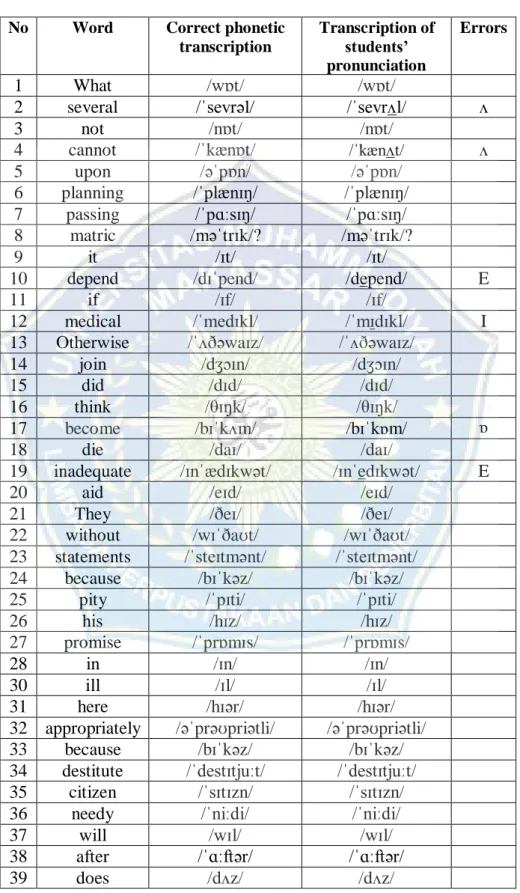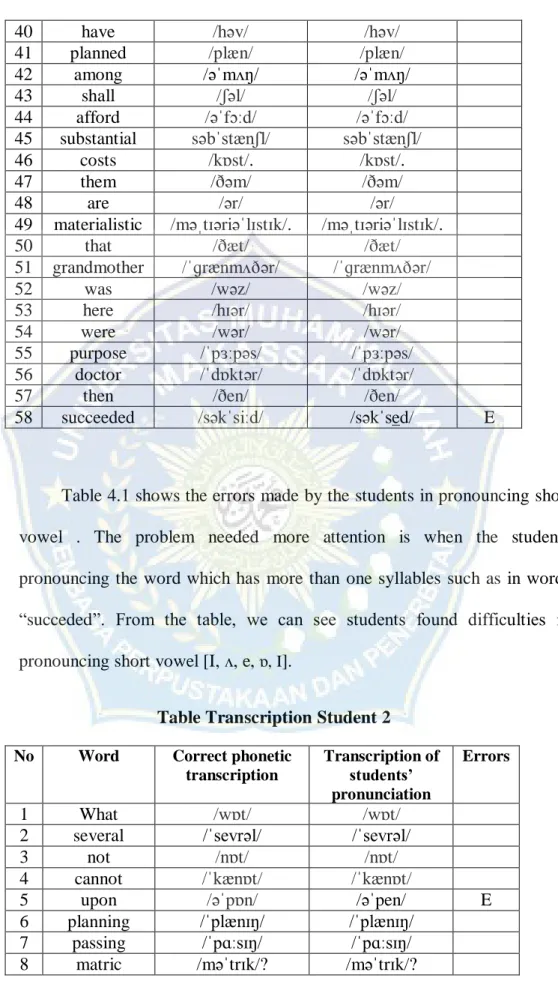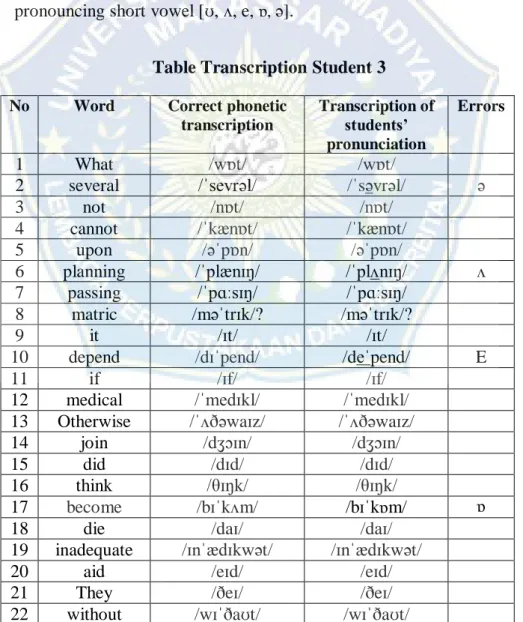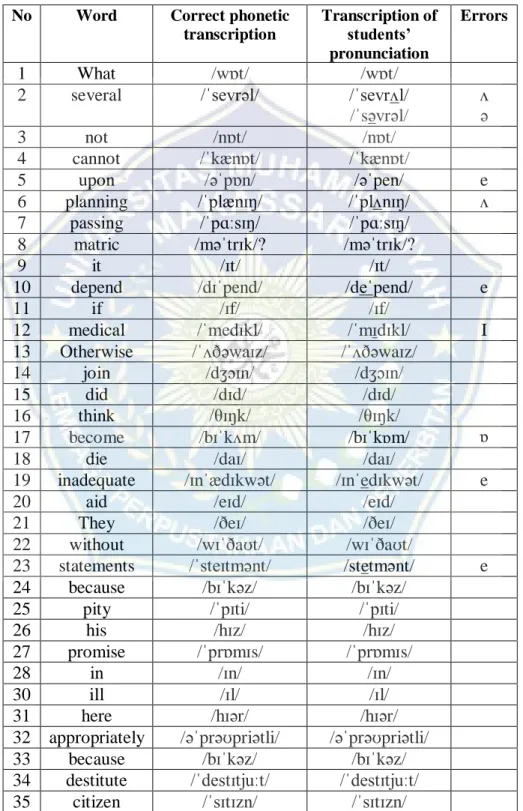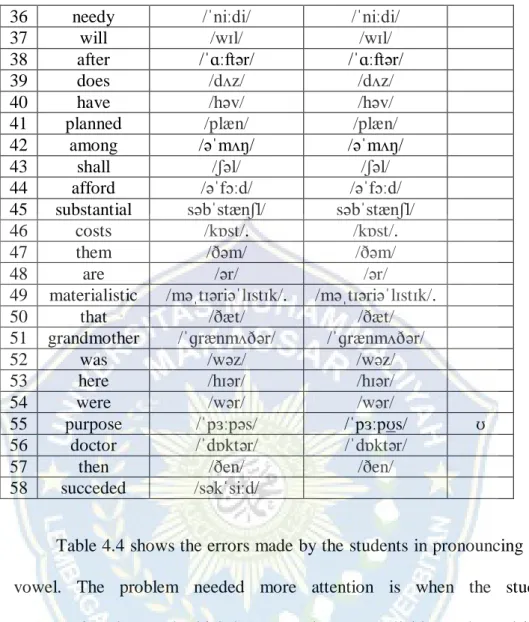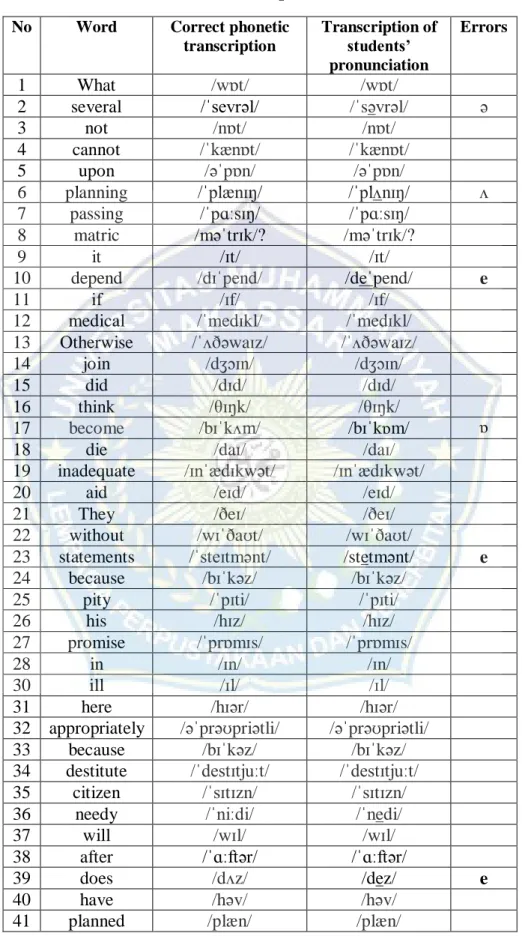Analisis Kesalahan Pengucapan Vokal pada Mahasiswa Baru Jurusan Pendidikan Bahasa Inggris Universitas Muhammadiyah Makassar. Analisis Kesalahan Pengucapan Vokal pada Mahasiswa Baru Jurusan Pendidikan Bahasa Inggris Universitas Muhammadiyah Makassar. Tujuan dari penelitian ini adalah untuk mengetahui kesalahan pengucapan vokal pada mahasiswa tahun pertama Jurusan Pendidikan Bahasa Inggris Universitas Muhammadiyah Makassar dan penyebab kesalahan pengucapan vokal pada mahasiswa tahun pertama Jurusan Pendidikan Bahasa Inggris Universitas Muhammadiyah. Makasar.
Hasil penelitian ini menunjukkan bahwa sebagian besar siswa masih melakukan kesalahan saat mengucapkan kata-kata bahasa Inggris yang bervokal pendek.
- Background
- Research Question
- Objective of the Study
- Significance of the Study
- Scope of the Study
Due to the fact that teaching English to pronounce skills needs extra strategies to build students' positive mindset and environment. It is in contrast to articulation, which refers to the actual production of speech sounds in the mouth, pronunciation emphasizes more the way sounds are perceived by the listener, eg: You have not pronounced this word correctly, and often relates the spoken word to its written form, eg: In the word knife, the k is not pronounced. In learning word stress, students are relied upon to have the ability to recognize the syllable/words focused when they are paying attention to English language.
Then, at this point in phonics learning, they rely on students being able to communicate meaning and feeling when they speak.
Previous of Related Finding
Abbas Pourhosein Gilakjani from Iran talks about “The Meaning of Pronunciation in English Language Teaching” and argues that learning pronunciation is very important for students. Nusrat Jahan's journal on "Teaching and Learning Pronunciation in ESL/EFL Classes of Bangladesh" states that students in Bangladesh have very poor pronunciation. The subjects of this study are the first students of the English Education Department of Muhammadiyah University of Makassar, as well as the students who practice pronunciation in their subject, while the subjects of previous studies were primary and secondary school students.
The research design used in this study is a qualitative study to analyze the vocal mispronunciation of the students.
Some Pertinent Ideas
The front of the tongue is raised a little to a point halfway between the . . open and the half open position; c. The elevation is somewhat advanced from the right rear position; c. The elevation of the tongue is but slight so that it may be said that the tongue is very low in the mouth, and is then in the fully open position; d. Although it is classified as a back vowel, the lips for the production of [a:] are not rounded, but they are neutral; e.The jaws are quite wide apart.
This student should actually have produced the /s/ sound at the end of the word, but she omitted it.
Conceptual Framework
Moreover, studying learners' errors serves two main purposes: First, it provides data from which conclusions can be drawn about the nature of the language learning process. Second, it indicates to teachers and curriculum developers which part of the target language students have the most difficulty producing correctly, and which types of errors impair students' ability to communicate effectively. The fact that students make mistakes and these mistakes can be observed, analyzed and classified is called error analysis.
In this case, we need to compare the sentences produced by the students with what appears to be the normal or correct pronunciation in the target language, which correspond to them. Describing errors: once errors have been identified, they can be described and classified into types or categories. Error assessment: when the purpose of error analysis is to help students learn, there is a need to assess errors.
Some errors may be considered more serious than others because they are more likely to affect the intelligibility of what someone is saying. The researchers are preparing to collect data by interviewing and documenting the students' ability to pronounce vowels. Hopefully, the researcher will be able to know and analyze the vowel pronunciation error after implementing this conceptual framework below.
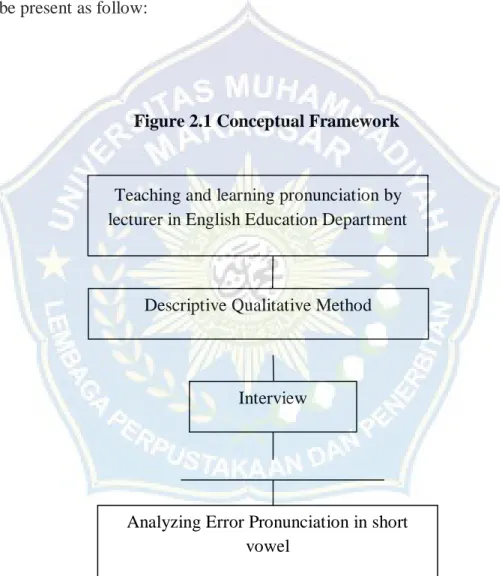
- Research Design
- Research Subject
- Research Instrument
- Method of Data Collection
- Method of Data Analysis
In this research, there is no intervention by the researcher in the teaching of pronunciation as it is the usual strategy of the pedagogues in teaching the subject of pronunciation. As a result, the researcher believed that the first-year students of the Department of English Education can provide data. As a result, the researcher did not need to include the entire population as participants in the study.
In addition, there are several stages that the researcher was doing as a step in implementing the instrument. Simply, the researcher conducted interviews and recorded dialogue with the students to obtain additional information about the data collection. To collect the data, the researcher makes an agreement and meeting with the participants about the date and place to conduct an interview in their classroom.
The tools used by the researcher to collect the data is a mobile phone to record the sound of the participants. In data analysis, the researcher took some steps to analyze the data of the participants. The researcher analyzed the interview results in the transcript and by listening to the audio recorder that was taken and the last the researchers will select the specific information that will be needed by the researcher.
After collecting specific data from the interview results that were previously analyzed, in the next step the researcher provided an overview of the generated data in general. The researcher recorded the results, summarized the findings and completed the analysis of the data from this research in order to use it as a reference in determining the speaking skills of the students.
Findings
From the data, we can see that the students had difficulties in pronouncing the vowel [I], which forms the beginning of the first syllable in verbal statements. Another problem students face when pronouncing the short vowel [ə] is how to produce a vowel that is placed on the first syllable in a word. Many students made mistakes in the pronunciation of the vowel [Λ], especially in the pronunciation of the word "does" with most students.
The word word has two syllables, namely vowel [Λ] placed in the second syllable of the word. Meanwhile, both "does" have only one syllable with the vowel [Λ] placed in the middle as the nucleus of the syllable. Another mistake the students made is the substitution of the short vowel [ɒ] in /ˈkænɒt/ in the majority of students.
During his research, the writer discovered that the student was having difficulty pronouncing the short vowel [e] placed in the first syllable of the word. It turns out that almost half of the students made these mistakes. For research question number two, interviews were conducted with students to find out the causes of the pronunciation error in short vowels.
The result of the interview shows that the majority of students indicate that the reasons why the error in pronunciation occurs is due to the lack of practice and education about the classification of speech organs in English. Based on the statements of the students, they revealed that the cause of mispronunciation in vowels is due to the lack of vocabulary, lack of practice and less knowledge about the classification of speech organs.
Discussion
The correct phonetic transcription of this was /ˈsevrəl/. Thus, this example is also categorized as a vowel misformation error. For the short vowel /ʌ/, there was 1 error in the initial error and 2 errors in the middle error. A short vowel error occurred here means that the students used the wrong element in the pronunciation of a particular word, such as the /ə/ or /ɒ/ sound.
The malformation error occurred because he used the wrong form of the vowel like using the /ə/ sound in “/ˈʌðəwaɪz. Here the malformation of short vowels has occurred, it means that the students have used the wrong voice in the pronunciation of a certain word such as the sound /ə/ or /ʌ/. The malformation error occurred because he used the wrong form of the vowel such as using the / ʌ / sound in.
Short vowel error occurred here means that the students used the wrong element to pronounce a certain word like. The malformation error occurred because he used the wrong form of vowel like using the / ʌ / sound in "/ˈplænɪŋ/". Short vowel malformation happened here means that the students used the wrong element to pronounce certain words like /e/ or /ɪ/ sound.
The malformation error happened because he used the wrong form of the vowel like using the / ɪ / sound inside. In contrast, if these errors are caused by the target language and do not reflect the structure of the native language, but are usually caused by overgeneralization due to a lack of target language competence.
Conclusion
Also, the other sources of student errors are students over-generating the rules and confusing the spelling rule.
Suggestion
The researcher realizes that this research is not perfect enough to overcome the problems of students who made mistakes in pronouncing vowels in English words. She expects that the further researcher can apply a suitable technique to deal with the problem of students in pronouncing vowels in English words in order to enable the students to pronounce English words correctly. The problem that needed more attention is when the students pronounce the word that has more than one syllable, as in words.
The problem that needs more attention is when the students pronounce the word that is in the first syllables, as in words. The problem requires more attention when the students pronounce a word that has more than one syllable and a word in the second syllables, as in the words "at" and "inadequate". The problem that needs more attention is when the students pronounce the word that is in the second syllables, as in words.
The problem that needed more attention is when the students pronounce the word that has the first and second syllables as in the words "up" and "insufficient". The problem that needed more attention is when the students pronounce the word that in the first and second syllables as in words "Different" and "considerable". The problem that needed more attention is when the students pronounce the word that is in the first and second syllables, as in words "planning" From the table we can see that students had problems with short vowel [ʌ, e,] to express.
The problem needs more attention when students pronounce the word in the first and second syllables like the words "cope" and "substantial". The problem requires more attention when students pronounce the word which in the first and second syllables as in the words "declaration" and. B : Lack of practice and lack of habit in pronouncing difficult pronunciations so as to affect pronunciation errors.
B: As a student who is still studying English, I have a lot of mistakes in my pronunciation because there are many words that I don't know how to pronounce. A: Why do you think the error occurs?
